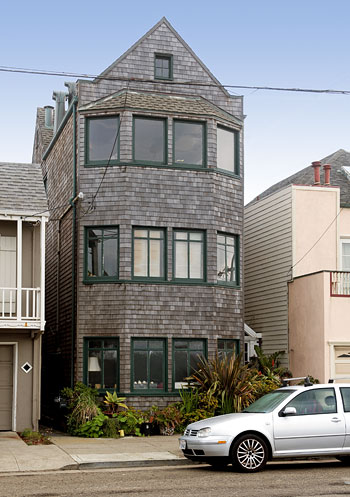National Register of Historic Places in San Francisco
Moss Flats Building
1626 Great Highway Between Lawton and Moraga
Built 1906
The Moss Flats Building is one of the few remainders from the early development of the ocean frontage as a beach and health resort and as a building constructed for the heir to the owner of Oakland's well-known Gothic Revival Moss Cottage.
The builder was Charles M. Depew, an experienced carpenter-builder-contractor who also experimented with businesses called the Depew Planing Mill, the Reversible Window Company, and the Pumice Stone Construction Company.
The Moss Flats had no architect, but Depew copied the then-popular Bay Area Shingle Style developed by such giants as Maybeck, Coxhead and Polk. The earliest known photograph, from 1928, shows the building covered in unpainted shingles, and with some flat, jigsaw-cut, decorative window surrounds typical of Bay Area Shingle Style.
Its survival can be attributed to its uniqueness within the temporary beach community. With the exception of two or three now vanished hotels at least six blocks further south, the Moss Flats Building seems to have been the only three-story structure on the beach south of Golden Gate Park. At the time of its construction, everything else in the vicinity was formed of obsolete and abandoned streetcars, imaginatively and otherwise adapted for use as clubhouses, restaurants and beach cabins, many with abundant gardens. If there were any yearround residents, they were artists or health seekers.
By contrast, the Moss Flats Building was substantial new construction, of typical beach-cabin style, multiplied by three stories. Originally intended as three beach rentals, its generous size, three-flat plan and strong construction permitted it to remain as permanent housing that produces income.
Less than nine years before the Moss Flats Building was erected, a newspaper reporter called what is now the Sunset district "the great desert of San Francisco."
Excerpted from the NRHP Nomination Form
